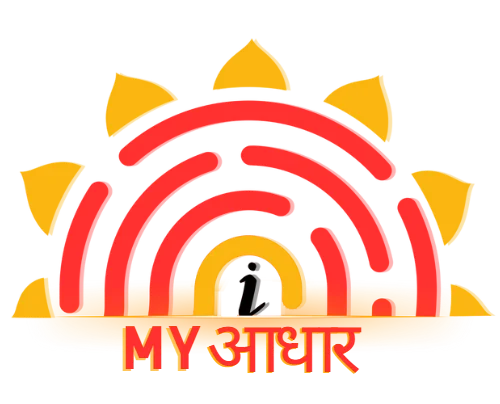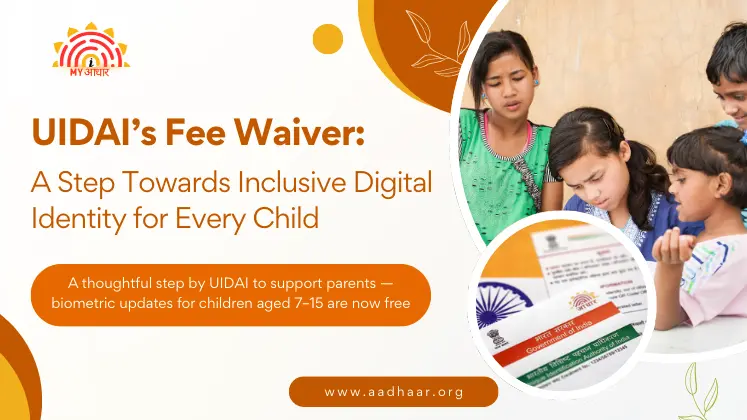To parents with small kids, maintaining official records can be a never-ending endeavor – school papers, health certificates and other identification documents. With the recent announcement that UIDAI waives fees for biometric updates, this process becomes even easier for families.
In a major step that should facilitate this process, the Unique Identification Authority of India (UIDAI) has announced a UIDAI fee waiver for the Aadhaar biometric update of children in the age bracket of Aadhaar update age 7–15 years. Known as a decision that will take effect on October 1, 2025, this decision is a significant relief to the families all over India.
In this blog, we will discuss what the new UIDAI circular entails, why the biometric update is valuable, and how parents can benefit by exploiting this free update (which has a limited-time window).
What is an Aadhaar Biometric Update and Why Does It Matter?
At the time when your child was initially registered with an Aadhaar number, when claiming under 5, the UIDAI simply collected their basic demographic details, i.e. name, date of birth, gender and address with a photograph.
No biometric information was taken including fingerprints and iris scans, since the biometric pattern of children has not yet developed and is liable to change as they mature.
The fingerprints, iris scans and facial features of children become stable with age, UIDAI mandates the Aadhaar biometric update through the Mandatory Biometric Update (MBU) process to ensure accuracy and reliability in the Aadhaar database.
The provided biometric update guarantees that your Aadhaar number that is assigned to your child could be used efficiently to:
- School and college admissions
- Government scholarships and subsidies
- DBT (Direct Benefit Transfer) schemes
- Bank account linkage
- Digital verification processes for exams or identification
Unless this biometric update is done in time, there is a risk that the Aadhaar number will be temporarily inactivated, and this will result in inconvenience when accessing services.
Simply put, Aadhaar biometric update requires the child to attend an authorised enrolment or update centre, give his/her Aadhaar number, authenticate the information provided and take fresh fingerprints, iris scans, and photographs.
What’s the Latest Change by UIDAI? The Free UIDAI Fee-Waiver for Children Aged 7–15
On September 29, 2025, the UIDAI published an official memorandum that stated that, in children aged 7-15, the first Mandatory Biometric Update (MBU-I) would be paid without charge (one year) at the beginning of October, 2025. This is the core of the UIDAI fee waiver applicable to the Aadhaar update age 7–15 group.
Earlier Policy
In the past, UIDAI was open to free biometric updates of the children in two age brackets 57 years (first MBU) and 1517 years (second MBU). Any person updating more than these windows was required to pay a fee which was nominal (approximately 100 INR).
What’s New Now
Under this new waiver, UIDAI has provided the facility of free Aadhaar update for children aged 7–15, which serves as a gap to take into consideration the children who might have overlooked the previous update period.
This action is under the mission-mode of UIDAI so as to ease the number of children whose biometrics had never been updated following their initial Aadhaar enrolment.
Why This Update Matters
The ruling might be minor, but the consequences of it are enormous on both the families and Aadhaar system:
- Reduces Financial Burden:
The parents, particularly the low-income earners, do not need to pay update fees to their children’s Aadhaar under this one-year waiver period. - Prevents Deactivation:
Unauthenticated biometrics of Aadhaar numbers may be subjected to authentication errors or momentary deactivation. The release of the free update will ensure that the Aadhaar numbers of the kids remain active. - Ensures Access to Key Services:
A renewed Aadhaar will allow education benefits, government subsidies and identity based services such as school admission, payment of scholarships and DBT programs to continue being availed without disruption. - Promotes National Data Accuracy:
The right and current biometrics will allow UIDAI to possess a cleaner and more credible Aadhaar database to develop the digital identity infrastructure in India.
Key Concepts Parents Should Know
1. MBU – Mandatory Biometric Update
UIDAI requires all children who registered earlier before the age of 5 to be updated later on as their biometrics patterns are developed.
2. Important Age Milestones
- Below 5 years: Demographic information and photos are only taken.
- In 5–7 years: First biometric update (MBU-I) will be provided, free of charge.
- At 7–15 years: New waiver: Free biometric update once in Oct 2025.
- At 15 years: Second biometric update (MBU-II) needed to secure the stability of adulthood.
3. Fee Structure Before the Waiver
Previously, the Aadhaar updates attract the nominal charge of 100 per update. Those costs are completely saved in 7-15 years, one year with this waiver.
4. Risk of Non-Update
Not renewing the biometrics of your child after the required age may lead to Aadhaar being turned into an inactive state, which will lead to the inability to confirm the identity during exams at school, state benefits, or financial support.
What This Means for You (As a Parent)
Step 1: Check Your Child’s Aadhaar Status
- Check whether the Aadhaar of your child already contains biometrics information.
- In case they were enlisted under the age of 5, and have not had a renewal as yet, they are now overdue to receive one.
- This waiver will enable you to make this update (without being charged a fee) within the one-year period if your child is aged between 7 to 15 years.
Step 2: Locate an Authorised Centre
Go to an Aadhaar Seva Kendra nearest to you or any other authorised enrolment/ update centre. One of them is located via the official locator tool of UIDAI.
Step 3: Gather Required Documents
Carry:
- Existing Aadhaar card of child.
- The Aadhaar card of the parent (as evidence of correlation)
- School ID, birth certificate or other supporting documentation of the child.
- Proof address (had to change address)
Step 4: Visit the Centre with the Child
The parent/guardian and child have to be physically present.
- The operator will take fingerprints, iris scans and new photos.
- Make sure that all the information of your child is right in the system.
Step 5: No Fee to be Paid
In the new policy, there will be no fee charged in this update to children in the age of 7-15 in the waiver period. Acknowledgement slip should be requested at all times.
Step 6: Keep Your Mobile Number Active
UIDAI also sends confirmation and alerts to the registered mobile number. In case you do not get a message in a few days, you can visit the update status online.
Act Now — Don’t Wait!
Such a window of fee waiver is limited to a year, beginning October 1, 2025. Parents are advised to move early enough so as to avoid scrambles in Aadhaar centres, at the last moment.
Delaying could mean:
- Re-paying the regular update fees once the waiver has been made.
- Deactivation of Aadhaar number as an authentication identity.
- There were school admission problems or government-related benefits.
With this up-to-date, you will be guaranteed that the Aadhaar of your child is operationalized to the fullest extent possible and you will save the inconvenience of visiting the office a number of times in future.
Helpful Reminders for Parents
- Carry original papers and photocopies.
- Wipe the child with his hands and eyes avoiding oil or glaze which contributes to the improved biometric capture.
- Carry the Aadhaar number as the hardcopy or in your phone.
- Keep update receipt or acknowledgement slip – this acts as an evidence of free update and successful submission.
- Monitor the update using the UIDAI site or call centre.
Why This Move by UIDAI Makes Sense
The project is one of the wider activities of UIDAI that has endeavored to streamline the Aadhaar maintenance process and support inclusiveness in digital identity management.
1. Easing Financial Barriers
Even minor administrative charges might act as a disincentive to a large number of families in rural and low-income neighborhoods. This fee waiver gets rid of this obstacle altogether making sure that every child is not left behind.
2. Promoting the Ease-of-Living Mission
Having proper biometrics, Aadhaar would be a painless facilitator of government schemes, scholarships, school admissions and, even, online exams – which would help India achieve its objectives of Digital Governance.
3. Clearing Backlogs
The UIDAI data indicate that millions of Aadhaar records of children are not fully developed due to the absence of biometric upgrades in millions of cases. With this program, there is an incentive to complete in time and minimize database errors.
4. Strengthening Identity Integrity
An accurate biometrics enhances the accuracy of Aadhaar authentication systems and diminishes cases of mismatch of biometrics that render the system highly secure and credible.
Conclusion
It is not just an administrative change that UIDAI has chosen to waive the fees on the update of biometrics in children aged between 7 and 15, but it is a move that will one day result in the inclusion, affordability, and accessibility of digital identity management to all children in India.
With this free update window, parents will be able to keep their child Aadhaar alive, proper and future proof. The solution is easy, the advantage is long-term and the time is right.
Therefore, in the event that your child is within this age group it is time to make it a point – go to your nearest Aadhaar centre, get a biometric refresh period and ensure that your child remains a part of the burgeoning digital world of India.
DISCLAIMER: This blog provides general information only. For official and updated guidelines, please visit https://uidai.gov.in/
FAQs
Q. What has UIDAI announced recently?
A. UIDAI has increased the update of the biometric of children between the ages of 7-15 years, which will be free of charge within one year, beginning on 1 October 2025.
Q. What is a biometric update in Aadhaar?
A. It involves the process of renewing the fingerprints, iris scan and photo of the child to make sure that the Aadhaar details are correct.
Q. Who is eligible for the free biometric update?
A. Any child between the ages of 7 and 15, whose biometrics is yet to be updated, is to receive a free upgrade during the one-year waiver.
Q. Why is a biometric update necessary?
A. Biometric characteristics change with age in children. By updating, the Aadhaar will continue being valid in school admissions, scholarships, and benefits provided by the government.
Q. What documents are needed for the update?
A. The child will require his Aadhaar number, a parent or guardian identification and address proof, and a birth or school certificate.

